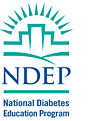 |
||||
 |
||||
Diabetes affects individuals, families, and communitiesFacts
A series of focus groups was conducted by the Association of American Indian Physicians (AAIP), in which tribal leaders, Indian health professionals, and American Indian community members expressed a strong preference for diabetes education materials relevant to their specific tribe or culture. In response, the Community Partnership Supplement was developed to provide examples of activities, ideas, and tips to help your community take action toward controlling diabetes. |
||||
A Joint Initiative of the National Institutes of Health and the |
||||
NDEP
Home | About
Diabetes | Resources
for Health, Education, and Business Professionals DHHS
Home | NIH
Home | NIDDK
Home | CDC
Home |
||||

Includes information about managing the ABCs of Diabetes. Also features information for people with diabetes who are eligible for Medicare benefits.
Learn how to prevent or delay type 2 diabetes through small steps.





